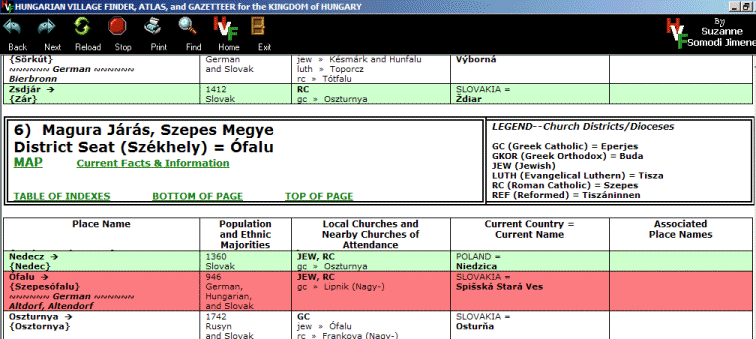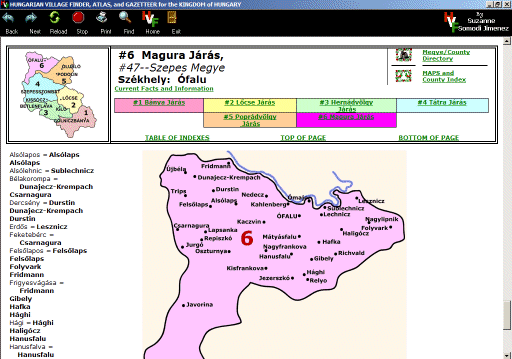
Austro-Hungarian
Ancestry, Heritage, Roots, and Genealogy
with the
HUNGARIAN VILLAGE FINDER,
ATLAS, and GAZETTEER for the KINGDOM of HUNGARY

| HUNGARIAN VILLAGE FINDER, ATLAS, and GAZETTEER for the KINGDOM of HUNGARY |
 |
Researching your Austro-Hungarian Ancestry, Heritage, Roots, and Genealogy with the HUNGARIAN VILLAGE FINDER, ATLAS, and GAZETTEER for the KINGDOM of HUNGARY |
 |
Whether you are working on a family tree, trying to find relatives overseas, writing your family history, or just plain curious about your origins, the following guide is for anyone researching their Austrian, Croatian, German, Hungarian, Polish, Romanian, Rusyn, Ruthenian, Serbian, Slovak, Slovakian, Slovenian, Ukrainian, or Yugoslavian ancestry, heritage, roots, and/or genealogy in the old Austria-Hungary Monarchy, Kingdom of Hungary, or Austro-Hungarian Empire. Since, for many of us, it's always the getting started that seems to be the most difficult, this guide was written to show you how you can begin locating your ancestral town in the homeland in 4 easy steps. Most genealogists, whether professional or hobbyists, will tell you that in order for your research to have any success at all, the first and most important thing you need to do is to learn the birthplace(s) of your ancestors. Unfortunately, this is not always as simple as it sounds. Since the majority of our ancestors emigrated before the breakup of the Austro-Hungarian Empire in 1918, most of these birthplaces were recorded in Hungarian (Magyar), however, the official Hungarian name was not necessarily the same as those used by the natives of a particular village, and after the “Magyarization” policy was put into effect, many names may have been changed altogether. To complicate matters even more, if your ancestor was of an ethnicity other than Hungarian, he or she might have entered the birthplace using a variant name such as German, Croatian, Romanian, etc., and depending on what document (see the guide: Locating ancestral towns, villages, places, settlements, and place names) the birthplace is obtained from, you might even find several different place names recorded. For example, it is not unusual to find that the birthplace entered on an immigrants ship’s passenger manifest is quite different than the birthplace entered in marriage certificates, naturalization papers, or on social security applications, even though they are all one and the same place. Therefore, once you have a name for a birthplace, the second
thing you have to do is to try and determine what place name was actually
used when your ancestor was born and when he or she immigrated.
Having
acquired that information, if your ancestor was born before 1895 when
civil
recordkeeping became manadatory, the third
step will be to try and learn your ancestor’s religious denomination,
which
will then allow you to begin searching for the actual records necessary
to begin extending your family tree. Keeping in mind that your Catholic grandfather might have been baptised Greek Catholic, Roman Catholic, or even Greek Orthodox, knowing the correct religion will help you to locate what and where the church records for births, marriages, and deaths, were kept. These are the records which have, hopefully, been filmed by the Latter Day Saints (LDS). Step four will require you to have access to a computer with a connection to the Internet, or to locate, and then visit your nearest LDS Family History Center. Either one will allow you to perform a search for records pertaining to your ancestor’s place of birth or the nearest village where vital events were performed and recorded. Provided you are lucky and find the entries for your village of interest, for a small fee (usually less than $4.00 per roll of film) you will then be able to obtain and use the microfilms at any local LDS Family History Center. A few years ago, accomplishing the four previously listed steps might have been a time consuming, expensive, and even futile effort, however, today with access to a computer and the software: HUNGARIAN VILLAGE FINDER, ATLAS, and GAZETTEER for the KINGDOM of HUNGARY (HVF), you may be able to complete all 4 steps in less than an hour’s time. Here’s an example of how: This place of birth was listed on a 1906 passenger manifest taken from the online Ellis Island Passenger Search website: First impressions of the above place name might suggest "Altwclarf or perhaps Altiuclarf," so they are the first names looked for in the HVF. Since neither one of these were listed in the Alphabetical Index for the letter "A", the next step is to try and narrow down the search by selecting groups of letters which are fairly accurate assumptions, hence the place of birth becomes Alt -- -- -- --arf, with the -- -- -- -- representing letters which are presently unknown. Using the HVF program and accessing the Alphabetical Index (Without Accents) for the letter “A” and the built-in “FIND” tool, the letters “arf” are entered. The results, however, are again negative which means there are no placenames beginning with the letter "A" and ending with "arf." After looking at the handwritten name again, the letter group "orf" is now tried. Although this produces several entries containing the letters "orf", only two begin with the letters “Alt” and end with the "orf," and both of these are shown as German {G} names for the same place. Altdorf {G} = Ofalu (47--6) (A comparison with the original handwriting shows that it is now quite simple to see that the "o" was easily mistaken for an "a" and the possible letters of "cl" are definitely the letter "d" resulting in the placename: Altendorf). A quick link to the megye (county) and járás (district) represented by the (47--6) provides the following excerpts: #47 Szepes Megye6) Magura Járás, Szepes Megye District Seat (Székhely) = Ófalu  In just a few minutes, an
unreadable Alt -- -- --
--orf
has
become
Altendorf, the German name (a clue that the person was most likely of
German
ethnicity) for Ófalu which, at a later date, was either
officially,
magyarized, or renamed to Szepesófalu, in Magura
Járás,
Szepes Megye. A quick glance advises that Ófalu is now in
Slovakia and called Spišská Stará Ves. More
important,
however, is the information that within the village, there was a Jewish
Synagogue and a Roman Catholic Church, while Greek Catholics had to
attend
services in the nearby village Nagylipnik.
Using the provided links to the online LDS Family History Library Catalog, an Internet connection is made from the HVF program directly to the old megye (county) of Szepes. Following the prompts, the researcher learns that not only are the Ófalu Roman Catholic Church (1762-1927) and Jewish (1850-1942) records available for ordering, but the 1869 census can be ordered, as well! A final check shows that the Greek Catholic Church (1787-1895) records for Nagylipnik are also available. As an added plus, with the HVF map for Szepes Megye broken down into járás (districts), and each járás shown with a list of every village located within its borders during a specific time period, and with Internet links to old maps of Szepes in the Kingdom of Hungary or Austria-Hungary Empire, the researcher is easily able to see where Ófalu was located. Finally, a quick search for "Spišská Stará Ves" in the HVF's Current Facts and Information for Szepes Megye gives the following information:  Once you know the correct place name, where it was located and where it is today, you should be well on your way to discovering your family's roots and building your own family tree. Just try entering "Spišská Stará Ves" into GOOGLE. The return results are 379,000 in .20 seconds! And don't forget to try online phone books for the current country to see if anyone with your surname still lives in the town or perhaps nearby. Then you can look for your place of interest on current map sites like Map Quest and Multimap.com (links included in the HVF), or an interactive map for the country you are searching. And just think, when your research leads you to a new place name, as undoubtedly it will, you'll already have the tool in hand to quickly locate the town and begin gathering information for further researching. It’s just that simple, and NOW, with the HUNGARIAN VILLAGE FINDER, ATLAS, and GAZETTEER for the KINGDOM of HUNGARY software program, YOU too, may be able to accomplish a search just as easily. Order your's today to begin tracing your family tree and impressing your relatives and friends with your success. HAPPY HUNTING!! A
genealogical “gold mine”
for anyone researching their
Austro-Hungarian heritage.  Place your ORDER here!! or Read on to see what others are saying about the Hungarian Village Finder, Atlas, and Gazetteer for the Kingdom of Hungary  |
|
Hungarian Village Finder, Atlas, and Gazetteer
for the Kingdom of Hungary (website) and Hungarian Village Finder, Atlas, and Gazetteer for the Kingdom of Hungary (software) Copyright 2001-2005 All rights reserved. |